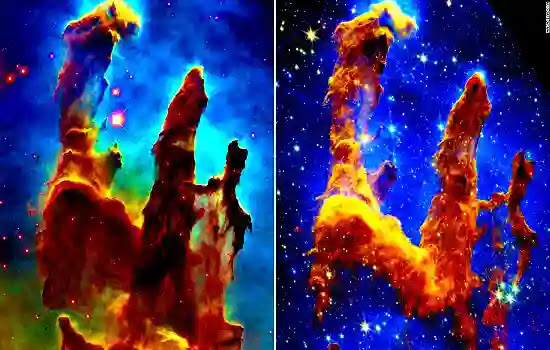The James Webb Space Telescope has captured an extremely detailed image of the so-called Pillars of Creation, a view of three looming constellations made of interstellar dust and gas glowing with newly formed stars.
This region, located in the Eagle Nebula about 6,500 light-years from Earth, was captured by the Hubble telescope in 1995, creating an image considered "iconic" by space observers.
The fact that new stars are brewing inside the cosmic gas and dust plumes is what earned the region its name.
The Webb Telescope used the Near Infrared Camera, also called NIRCam, to give astronomers a new close-up view of the region, as they peer through some plumes of dust to reveal more small, bright red stars.
A press release from the European Space Agency reads: "Newly formed protostars steal the scene." "When nodes of sufficient mass are found within the gas and dust plumes, they begin to collapse under the influence of their gravity, slowly heat up and eventually form new stars."
Since Hubble took the first image of the region in the 1990s, astronomers have returned to the scene several times. For example, the European Space Agency's William Herschel Telescope also took an image of a different stellar birth region, and Hubble created its follow-up image in 2014. Each new instrument aimed at the region gives researchers a new view. European space. Agency. .
"Along the edges of the plumes are wavy lines resembling lava. They are spewed out by stars that are still forming. Young stars periodically release jets that can interact in clouds of matter, such thick plumes." of gas and dust”, accordingly. To the press. Release.
"This also sometimes leads to bow shocks, which can form undulating patterns like a boat as it moves through the water," it reads. These young stars are estimated to be a few hundred thousand years old and will continue to form for millions of years.
Webb is operated by NASA, ESA, and the Canadian Space Agency. The $10 billion space observatory, which launched last December, has enough fuel to continue capturing unprecedented images of the universe for nearly 20 years.
Compared to the capabilities of other telescopes, the Space Observatory's powerful massive infrared mirror technology can reveal faint, distant galaxies otherwise invisible, and Webb has the potential to advance our understanding of the origins of the universe.
Some of Webb's first images, released since July, have shed light on the observatory's abilities to reveal never-before-seen aspects of the universe, such as the birth of stars covered in dust.
However, astronomers also use the telescope's sharp, still image quality to illuminate our solar system, and so far have taken pictures of Mars, Jupiter and Neptune.


Comments
Post a Comment